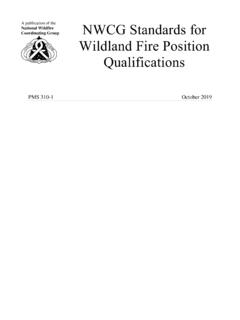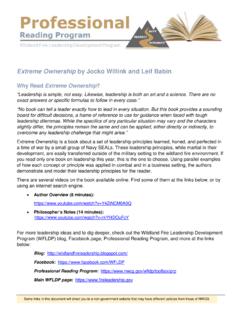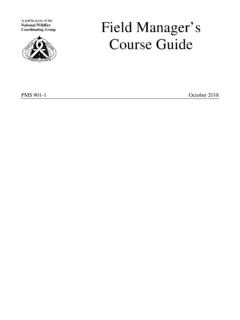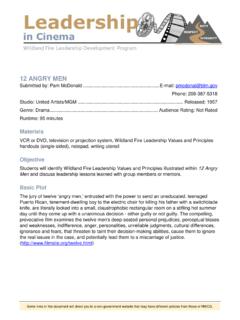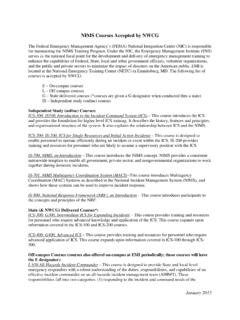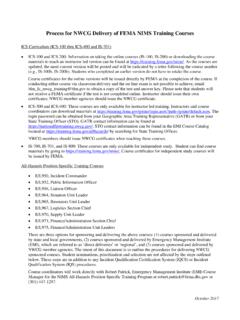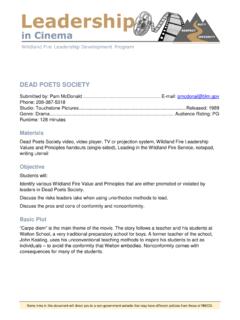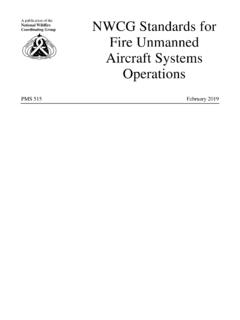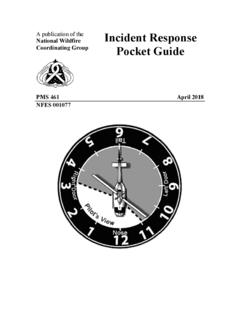Transcription of PMS 051 Wildland Urban Interface Wildfire Mitigation Desk ...
1 A publication of the National Wildfire Coordinating Group Wildland Urban Interface Wildfire Mitigation Desk Reference Guide PMS 051 June 2019. Wildland Urban Interface Wildfire Mitigation Desk Reference Guide June 2019. PMS 051. The Wildland Urban Interface Wildfire Mitigation Desk Reference Guide provides basic background information on relevant programs and terminology for those, whether community members or agency personnel, seeking to enhance their community's Wildfire Mitigation efforts. The four primary objectives of this reference guide are to: Provide a reference to assist with integrating Wildland Urban Interface Mitigation principles into national Wildland fire training;. Promote common Wildfire Mitigation language and culture.
2 Establish an authoritative source for Wildland Urban Interface Mitigation information; and Provide consistent definitions for use by all media. The National Wildfire Coordinating Group (NWCG) provides national leadership to enable interoperable Wildland fire operations among federal, state, tribal, territorial, and local partners. NWCG. operations standards are interagency by design; they are developed with the intent of universal adoption by the member agencies. However, the decision to adopt and utilize them is made independently by the individual member agencies and communicated through their respective directives systems. Table of Contents Wildland Urban Interface (WUI) .. 1. What is Wildland Urban Interface ?.. 1. What is Mitigation ?
3 1. Why is Mitigation Important in the Wildland Urban Interface ? .. 1. Mitigation Principles .. 1. Risk Assessment .. 1. Risk Reduction .. 2. Basic Components of WUI Mitigation .. 2. Fire Adapted 2. Community Wildfire Protection Plan .. 3. State/Tribal/Local Hazard Mitigation Plan .. 3. Homeowner Wildfire Mitigation .. 4. WUI Mitigation Resources .. 5. Fire Adapted Communities Coalition .. 5. Fire Learning Network .. 5. Fire Safe Councils .. 5. Firewise Communities .. 6. Hazard Mitigation Assistance .. 6. Living with Fire .. 6. Ready, Set, Go! .. 6. Background Materials Policy and Research .. 7. Healthy Forests Restoration Act (HFRA) of 7. National Cohesive Wildland Fire Management 7. Presidential Policy Directive .. 7. Quadrennial Fire Review.
4 8. Research Efforts .. 8. Whole Community .. 8. i Wildland Urban Interface (WUI). The effects of Wildland fire on communities have become more intense, frequent, and far-reaching. Increased development in the Wildland Urban Interface (WUI) means higher Wildfire risk and more suppression needs, costing billions every year. A comprehensive approach to preparedness and Mitigation is an effective way to address increasing suppression costs and reduce risk to communities. Mitigation happens at all levels local, state, tribal, and federal. A combined approach helps achieve fire adapted communities. Individuals, communities, and organizations working together to share and leverage resources and build partnerships are the keys to success.
5 This guide defines terms and identifies resources that are useful in Mitigation planning efforts for all lands. What is Wildland Urban Interface ? Generally speaking, WUI refers to the zone of transition between unoccupied land and human development. It is the line, area, or zone where structures and other human development meet or intermingle with undeveloped Wildland or vegetative fuels. Communities adjacent to and surrounded by Wildland are at varying degrees of risk from wildfires. What is Mitigation ? Mitigation is the effort to reduce loss of life and property by lessening the potential impact of disasters. Why is Mitigation Important in the Wildland Urban Interface ? Undertaking Wildfire Mitigation in the WUI can reduce or eliminate the risk of damages caused by Wildfire to the human environment (homes, neighborhoods, communities).
6 These actions offer multiple benefits including: Contributing to firefighter and public safety by reducing fuels and lessening the risk of structures igniting. Creating communities that are more resilient by reducing loss of life and property damage. Allowing individuals and communities to minimize post-disaster disruptions and recover more rapidly. Lessening the financial impact on individuals, communities, and society as a whole. In many cases, Mitigation work also enhances other important values such as ecological benefits and aesthetics. Mitigation Principles A comprehensive Mitigation approach based on a risk assessment is important for decision making in order to distinguish among various risk management options for accepting, avoiding, reducing, or transferring the risk.
7 Resiliency, or fire adaptation, is a continual process that results in effective risk management. Risk Assessment Risk assessment is a systematic process for identifying and assessing the range of elements that could lead to undesirable outcomes for a specific situation. Wildland Urban Interface Wildfire Mitigation Desk Reference Guide 1 of 9. Quantitative risk assessments provide a method by which we can calculate risk based on measurements or estimates of various risk components such as likelihood of fire occurrence, intensity of fire should it occur, and susceptibility to fire of the various values being evaluated. Qualitative risk assessment is the application of judgment based in knowledge and experience when assessing Wildfire risk, the potential for ignitions and recommendations regarding possible ways to mitigate the risk.
8 Risk Reduction The goal of risk reduction is to reduce the potential loss to life and property. This can apply to both existing and future conditions, and pre and post-disaster environments, through regulations, local ordinances, land use and building practices, and with Wildfire Mitigation projects. Basic Components of WUI Mitigation Fire Adapted Community The NWCG definition of fire adapted community (FAC) is A human community consisting of informed and prepared citizens collaboratively planning and taking action to safely coexist with Wildland fire. More fully, a FAC is a knowledgeable, engaged community where actions of residents and agencies in relation to infrastructure, buildings, landscaping, and the surrounding ecosystem lessen the need for extensive protection actions and enable the community to safely accept fire as part of the surrounding landscape.
9 A successful FAC approach has the potential to save lives, homes and communities, and millions of dollars in suppression costs annually and allowing beneficial ecological processes of fire to take place. The concept of FAC does not refer to a specific program but a dynamic state of being in which the community continually strives to reduce Wildfire risk factors. Becoming a FAC is a continuous process that requires maintenance and adaptation to ensure actions are effective. Regular re-assessment of risk factors will be required to remain fire adapted. Because all stakeholders share Wildfire risk, a FAC strategy stresses that everyone shares responsibility for mitigating the risk. Stakeholders in a FAC include residents, businesses, policy-makers, land managers, and emergency responders, as well as local, state, tribal, and federal governments.
10 Engaging in a FAC approach can be encouraged by all levels of government through: Support for outreach programs to engage the public in Mitigation efforts;. Mitigation incentives; and Improved application of relevant research findings on structural ignition, fuels reduction, and key social dynamics. There is a range of actions communities can undertake to become more fire adapted. In general, the more elements that a community has addressed, the more fir will become. As every community is unique, not all elements listed below will be emphasized to the same degree in each community. Major elements of a FAC include: Community Wildfire Protection Plan or an equivalent plan that helps the larger community identify key values and ways to mitigate fire risk.
